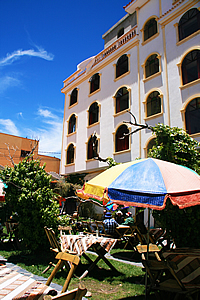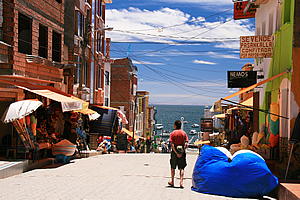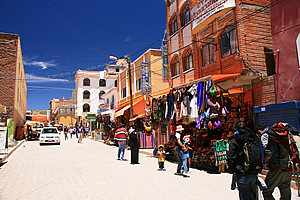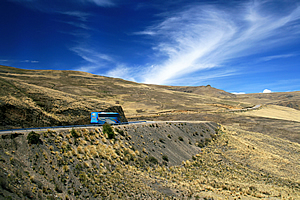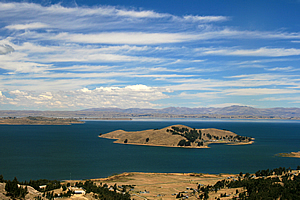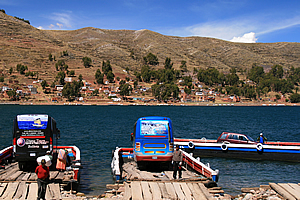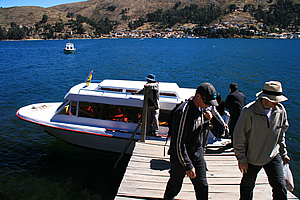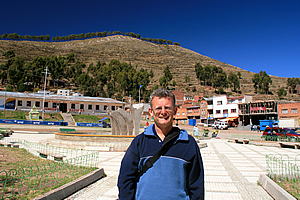--- Archive files ---
Home > Travels > Titicaca > 9 |
Buses Afloat
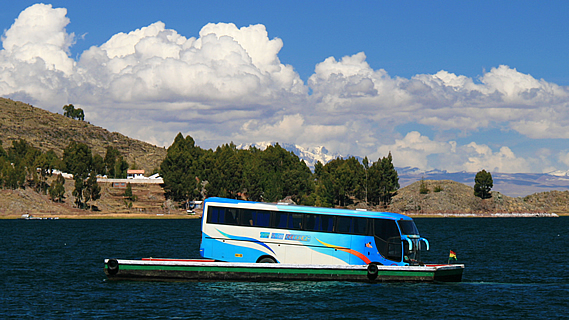
ONCE through customs on the Bolivian side of the Peru/Bolivia border we left the building and climbed onto the bus. It took off leaving the border village of Yunguyo to cross a short valley before winding up a steep hill towards a small pass. Once over the pass we arrived in a small town that was very nicely set up compared to any of the Peruvian towns we had passed since leaving Cuzco.
Copacabana |
Copacabana was quite up market giving a great first impression of Bolivia despite it being the poorest country in South America. The rest of my group were singing a Spanish song about Copacabana which I had never heard before. Apparently the song is about the main beach in Rio de Janeiro of the same name. No one seemed to care about that though. So far as they were concerned they were already here.
The bus stopped and let us all out. We took our bags and took them through the tiny bus station to a back room where we dropped off our main bags. It wasn’t exactly secure there with both the doors to the small check in room and the back door being wide open. Hopefully no one would steal them. Carlos then led us through the back door passing through the entrance to a courtyard surrounded by two to four storey buildings with distinctively Spanish arches. The courtyard had plenty of colourful tables giving a very Southern European feel even though we were in the middle of South America.
We took a large table and ordered lunch. A dark skinned man with a mop of jet black hair came and handed out menus. Although it was a rather cold, the bright sun was very strong. Mind you we were just above the lake at about three thousand nine hundred and fifteen metres above sea level.
Copacabana |
I ordered fish (fresh from the lake of course) with a lettuce salad and chips. The food here was very good. We were all relaxed despite the sunshine being intense and hot and the shade being freezing as was typical of these high altitudes.
Once we had finished eating lunch, I joined Carlos who was sitting with someone he obviously knew. I chatted to them for a few minutes before heading for a walk down the street to the lake’s edge, to a place where local legend tells of a sunken city exists on the lake bed close offshore and underwater archaeologists have now discovered it. We didn’t stay long as the bus was due to depart shortly, so we walked back up the street passing numerous market stalls.
Copacabana |
Copacabana is the second largest settlement on the shores of the lake, the largest being Puno in Peru where we had come from this morning.
A new bus had arrived, but we couldn’t board yet. We retrieved our bags from inside the bus station and waited out on the side of the street. Finally the bus driver returned from the tiny station and opened the cargo door for us to add our bags and climb on board. Fortunately the windows in this bus were a lot better coloured. They were discoloured only a slight dark blue colour. I could live with that having just travelled on a bus with bright sepia windows.
The long hill out of Copacabana |
The bus took off following the highway heading back up the hill. We climbed for a few minutes before reaching the top at around 4000 metres above sea level. Following a descent from the top we reached a narrow neck where the two sides of the lake came very close together. This was a deep channel marking the narrowest part of the lake separating two very large expanses of water.
We reached the small town of Tiquina straddling the side of the lake. Here the vast lake narrows to just 850 metres wide at the Strait of Tiquana. There is no bridge here, the only way across being by boat. This was the only way to and from Copacabana without having to cross the border into Peru, then back again into Bolivia.
Lake viewed from the pass |
To the left of the channel was the main lake known as Largo Grande where we had sailed yesterday. To the left was the much smaller and shallower Winaymarka having an average depth of only nine metres.
Here we got off the bus and walked around a small market. Here all the buses and other vehicles were loaded onto small barges to go across the deep purple channel of cold water. The barges were hardly bigger than the buses, and their freeboard was so low I was amazed they could stay afloat. No wonder we had been asked to get off. Curiously one of the barges had the name “Titanic” written on the side brushed roughly in white paint. I hoped that wasn’t an omen, but at least it wasn’t carrying our bus.
Ferrys at Tiquina |
There was a short queue to a small jetty where small launches were crossing the river. We queued up in amongst strategically located market stalls before eventually getting onto a small launch that seated about twelve people. Fortunately most of our group were together with a few other people probably from other buses. We put on life jackets before the boat left the pier and sped off across the choppy water. The ride was bumpy and the head wind was very cold despite us being mostly sheltered in the cabin. The dark water was crystal clear under the intense sunlight. From the boat I saw one of the barges carrying our bus across at a speed much slower than our boat. Hopefully it won’t tip over in the swell.
Leaving the launch |
After about five minutes we reached the other side and climbed out of the boat onto another small jetty. There were a couple more markets on this side of the channel in Tiquina, and quite a few old buildings. The town distinctly looked like what you would expect in a Western movie set to the extent that I was expecting gun slinging cowboys to suddenly arrive on horses.
One of the couples in my group arrived on the second boat, but Carlos was nowhere to be seen. Our bus was still crossing the channel, and amazingly it was still afloat. We waited around in the quiet sunny square, surprisingly devoid of locals.
Tiquina |
The bus finally arrived. The driver carefully drove it up the ramp and parked it in front of the closed shops to the left hand side of the square. Then Carlos came out of it – he had for the first time had a ride on the precarious barge. Now reunited with us we climbed back on board.
As we left the small town the lady sitting next to me asked me if I had any idea how far La Paz was. I said it was 127 kilometres away. She thought I was joking, but I said I was serious because I saw a sign in the town showing how far away it was.
<< Previous | Next >> |
|
||
About this Page
|
||
|
|
|
Where is Walkabout Jeff? |
|
|
|
|
What is happening in Walkabout Jeff's hometown?
|
|
|
|
|
Who is Walkabout Jeff?Any normal person's idea of going out involves going to the local pub for a drink with a few mates. Walkabout Jeff isn't normal.
|
|
|
|
|
